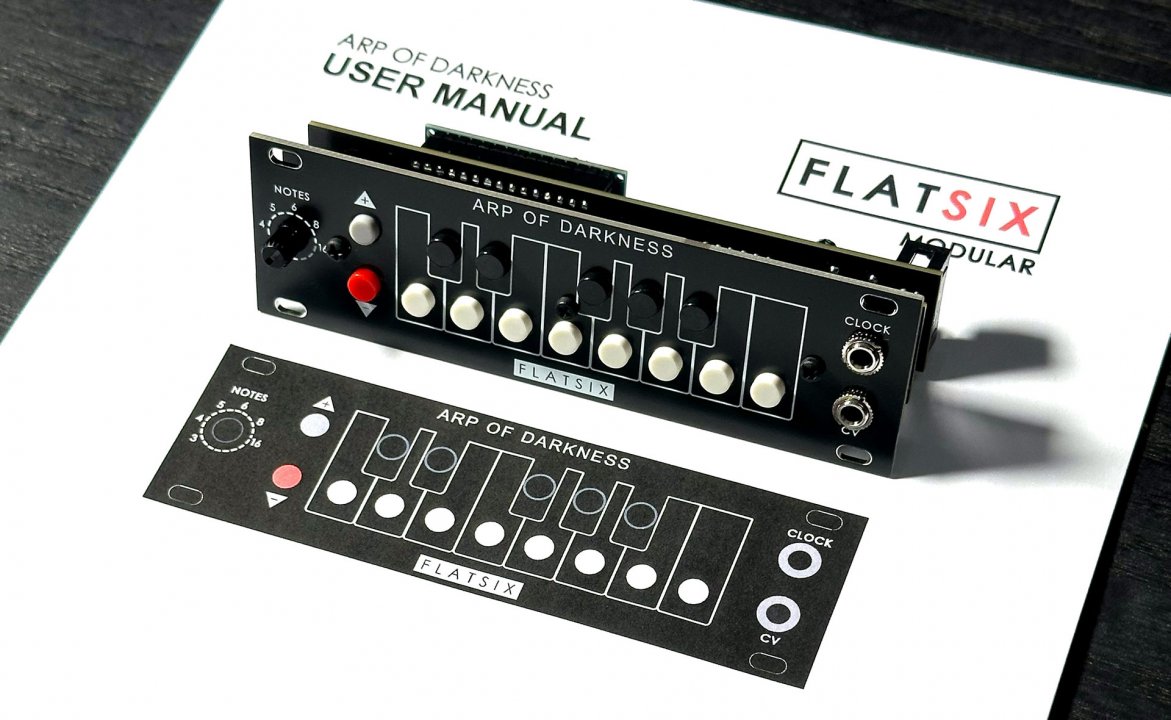Module is a 1U tile in Intellijel format
This Module is discontinued.
 Specs are approved by the manufacturer
Specs are approved by the manufacturerThe Arp Of Darkness is an arpeggiator with a unique twist

The Arp Of Darkness is an arpeggiator with a unique twist: It's designed to create dynamic and evolving note sequences by utilizing a buffer approach similar to a Turing Machine or Shift Register. Unlike traditional arpeggiators, which typically play chords as individual notes in a predefined pattern, this module allows you to enter notes sequentially into a buffer of variable length, (from 3 up to 16 notes) and play it back using 5 playback modes more commonly found in arpeggiators. (Forward, Backward, Exclusive Pingpong, Inclusive Pingpong, and Random).
This module is a part of the emerging Nocturne Alchemy Platform - a flexible eurorack module series that shares the same robust Arduino-based hardware, allowing one to effortlessly swap functionalities through our intuitive web loader. By purchasing one module, you gain access to a full range of freely available firmwares, including our current creations, Slight of Hand and Arp Of Darkness, as well as others planned for future release! It's like getting multiple modules for the price of just one!
Specs
* 1U (Intellijel format) 26HP Module
* 40mm skiff-friendly depth
* Current Draw: 40 mA +12V, 0 mA -12V, 0 mA 5V
Features
* 4 octaves of control from C0 to C4
* 6 note buffer lengths (3, 4, 5, 6, 8, 16)
* 5 playback modes (Forward, Backward, Exclu Pingpong, Inclu Pingpong, and Random)
* Clock input and CV out calibrated to 1V/0
* Calibration mode with tuning for each note across 4 octaves (Comes pre-calibrated)
User Manual: Arp Of Darkess User Manual V1.3.0
Website: https://www.flatsixmodular.com
MORE EXPLANATION
The Illusion of Randomness
The Arp Of Darkness is designed to leverage a musician's imperfect memory, creating the illusion of randomness. While the module provides structured playback modes, the human element introduces a layer of unpredictability. As musicians input notes and adjust settings, the evolving sequences can feel spontaneous and ever-changing, much like a Turing Machine or a Shift Register. However, the Arp Of Darkness stands out by inviting the musician's memory and intuition into the creative process, resulting in a unique and personalized musical experience.
Shift Register-ish Behavior
The Arp Of Darkness employs a similar concept to a shift register for handling note entry and playback. As new notes are entered into the buffer, older notes shift through the buffer and eventually "fall off" when the buffer is full. This process creates evolving sequences that change over time, offering a dynamic and engaging musical experience.
Step-by-Step Explanation
* Step 1: Initial Note Entry - When you enter the first note using the tactile keyboard, it is stored in the first position of the sequence buffer.
* Step 2: Filling the Buffer - As you enter more notes, each new note pushes the existing notes one position forward in the sequence buffer. For example, entering a second note moves the first note to the second position and places the new note in the first position.
* Step 3: Buffer Overflow - When the sequence buffer is full (based on the potentiometer setting), entering a new note causes the oldest note to "fall off" the buffer as all notes shift one position forward. The new note is stored in the first position, and the sequence continues to evolve.
* Step 4: Continuous Evolution - The Arp Of Darkness allows for continuous evolution of the sequence. As you enter new notes, older notes shift through the buffer, ensuring that the musical pattern is always changing and never static.
Practical Example
Imagine you set the sequence buffer length to 8 notes and begin entering notes:
Enter C -> Buffer: [C]
Enter E -> Buffer: [E, C]
Enter G -> Buffer: [G, E, C]
Enter B -> Buffer: [B, G, E, C]
Enter D -> Buffer: [D, B, G, E, C]
Enter F -> Buffer: [F, D, B, G, E, C]
Enter A -> Buffer: [A, F, D, B, G, E, C]
Enter C -> Buffer: [C, A, F, D, B, G, E, C]
Enter E -> Buffer: [E, C, A, F, D, B, G, E] (Oldest note "C" falls off)
https://www.flatsixmodular.com/#s-9cad7c01-4342-4b65-914f-74bf54a5a75d/
3 Users are observing this